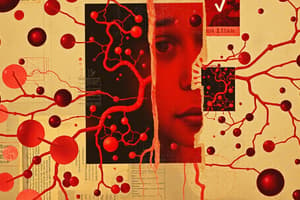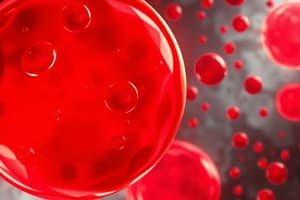Podcast
Questions and Answers
Which of the following best describes the role of blood in the human body?
Which of the following best describes the role of blood in the human body?
- Primarily involved in the digestion of nutrients.
- Exclusively responsible for waste removal from tissues.
- Transports nutrients and gases to cells while removing waste. (correct)
- Only functions to maintain body temperature.
Plasma constitutes approximately what percentage of the blood volume?
Plasma constitutes approximately what percentage of the blood volume?
- 25%
- 55% (correct)
- 75%
- 45%
Which of the following is the primary function of fibrinogen?
Which of the following is the primary function of fibrinogen?
- Transport of respiratory gases.
- Clotting or coagulation of blood. (correct)
- Defense mechanisms of the body.
- Maintaining osmotic balance.
What is the average lifespan of red blood cells (RBCs) in humans?
What is the average lifespan of red blood cells (RBCs) in humans?
Which type of white blood cell is the most abundant and acts as a phagocytic cell to destroy foreign organisms?
Which type of white blood cell is the most abundant and acts as a phagocytic cell to destroy foreign organisms?
What is the role of platelets (thrombocytes) in the blood?
What is the role of platelets (thrombocytes) in the blood?
Which blood type is considered the 'universal donor' due to the absence of A and B antigens on the RBCs?
Which blood type is considered the 'universal donor' due to the absence of A and B antigens on the RBCs?
What happens in erythroblastosis fetalis?
What happens in erythroblastosis fetalis?
Which mineral plays a significant role in blood clotting?
Which mineral plays a significant role in blood clotting?
What is the key difference between lymph and blood?
What is the key difference between lymph and blood?
Which type of circulatory system involves blood being pumped into open spaces or body cavities?
Which type of circulatory system involves blood being pumped into open spaces or body cavities?
What is the function of the sino-atrial node (SAN)?
What is the function of the sino-atrial node (SAN)?
What does the QRS complex in an electrocardiogram (ECG) represent?
What does the QRS complex in an electrocardiogram (ECG) represent?
Which of the following represents the correct sequence of blood flow in pulmonary circulation?
Which of the following represents the correct sequence of blood flow in pulmonary circulation?
What is atherosclerosis?
What is atherosclerosis?
Flashcards
What is Blood?
What is Blood?
A special connective tissue consisting of a fluid matrix, plasma, and formed elements.
What is Plasma?
What is Plasma?
The straw colored, viscous fluid constituting approximately 55% of the blood, composed of 90-92% water and 6-8% proteins.
What are Plasma Proteins?
What are Plasma Proteins?
Proteins found in blood plasma; include fibrinogen, globulins, and albumins.
What are the roles of Globulins and Albumins?
What are the roles of Globulins and Albumins?
Signup and view all the flashcards
What are Formed Elements?
What are Formed Elements?
Signup and view all the flashcards
What are Erythrocytes (RBCs)?
What are Erythrocytes (RBCs)?
Signup and view all the flashcards
What are Leucocytes (WBCs)?
What are Leucocytes (WBCs)?
Signup and view all the flashcards
What are Platelets (Thrombocytes)?
What are Platelets (Thrombocytes)?
Signup and view all the flashcards
What is ABO Grouping based on?
What is ABO Grouping based on?
Signup and view all the flashcards
What are Universal Donors?
What are Universal Donors?
Signup and view all the flashcards
What is Rh grouping?
What is Rh grouping?
Signup and view all the flashcards
What is Coagulation of Blood?
What is Coagulation of Blood?
Signup and view all the flashcards
What is Lymph (Tissue Fluid)?
What is Lymph (Tissue Fluid)?
Signup and view all the flashcards
What is an Open Circulatory System?
What is an Open Circulatory System?
Signup and view all the flashcards
What is the function of the Heart?
What is the function of the Heart?
Signup and view all the flashcards
Study Notes
- All living cells require nutrients and oxygen while waste must be removed.
- Efficient mechanisms are essential for substance movement to and from cells.
- Different animal groups have evolved various transport methods.
- Simple organisms, like sponges, circulate water through body cavities for exchange.
- Complex organisms utilize special fluids like blood and lymph for transport.
- Blood is the most common body fluid in higher organisms.
- Lymph aids in transporting certain substances.
- Composition, properties of blood/lymph, and blood circulation are discussed.
Blood
- Blood is a special connective tissue comprised of plasma and formed elements.
Plasma
- Plasma: Straw-colored, viscous fluid, approximately 55% of blood volume.
- Plasma consists of 90-92% water and 6-8% proteins.
- Fibrinogen, globulins, and albumins are major plasma proteins.
- Fibrinogens are for clotting.
- Globulins are for defense.
- Albumins are for osmotic balance.
- Plasma contains minerals (Na+, Ca++), glucose, amino acids, lipids, etc. in transit.
- Clotting factors are present in inactive form.
- Plasma without clotting factors is called serum.
Formed Elements
- Erythrocytes, leukocytes, and platelets form 45% of blood.
- Erythrocytes (RBCs): Most abundant blood cells.
- Healthy adults average 5 to 5.5 million RBCs mm⁻³ of blood.
- RBCs form in red bone marrow (adults), lack nuclei, are biconcave.
- Contain hemoglobin (iron-containing protein), for respiratory gas transport.
- Hemoglobin levels in healthy individuals range from 12-16 gms per 100 ml of blood.
- RBC lifespan averages 120 days.
- RBCs are destroyed in the spleen (graveyard of RBCs).
- Leukocytes (WBCs): Colorless (lack hemoglobin), nucleated, less numerous than RBCs.
- WBC numbers average 6000-8000 mm⁻³ of blood.
- Generally short-lived.
- Granulocytes (neutrophils, eosinophils, basophils) and agranulocytes (lymphocytes, monocytes) exist.
- Neutrophils most abundant (60-65%), basophils least (0.5-1%).
- Neutrophils and monocytes are phagocytic, destroy foreign organisms.
- Basophils secrete histamine, serotonin, heparin (inflammatory reactions).
- Eosinophils (2-3%) resist infections, allergic reactions.
- Lymphocytes (20-25%) are B and T forms, responsible for immune responses.
- Platelets (thrombocytes): Cell fragments from megakaryocytes (bone marrow).
- Blood contains 150,000-350,000 platelets mm⁻³.
- Platelets release substances for blood clotting.
- Low platelet count can cause excessive blood loss.
Blood Groups
- Human blood differs despite similarities.
- ABO and Rh groupings are widely used.
ABO Grouping
- ABO grouping is based on A and B antigens on RBCs, and natural antibodies in plasma.
- Blood transfusion requires matching donor and recipient blood to avoid RBC destruction.
- Group O blood can be donated to anyone (universal donors).
- Group AB individuals can receive blood from anyone (universal recipients).
Rh Grouping
- Rh antigen (Rhesus monkey-like) is present in ~80% humans (Rh positive).
- Individuals lacking the Rh antigen are Rh negative.
- Rh-ve individuals exposed to Rh+ve blood form anti-Rh antibodies.
- Rh group matching before transfusions is essential.
- Rh incompatibility can occur in pregnant Rh-ve mothers with Rh+ve fetuses.
- Anti-Rh antibodies given to the mother prevent erythroblastosis foetalis in subsequent pregnancies.
Coagulation of Blood
- Blood clotting prevents excessive blood loss after injury/trauma.
- A clot or coagulum forms, consisting of a fibrin network trapping dead and damaged elements.
- Fibrins forms from inactive fibrinogens with thrombin.
- Thrombins are formed from prothrombin.
- Thrombokinase is required for the reactions.
- The process involves linked enzymic reactions/cascade.
- Injury/trauma stimulates platelet release and coagulation mechanism activation.
- Tissues at injury site release factors initiating coagulation.
- Calcium ions are vital for clotting.
Studying That Suits You
Use AI to generate personalized quizzes and flashcards to suit your learning preferences.




